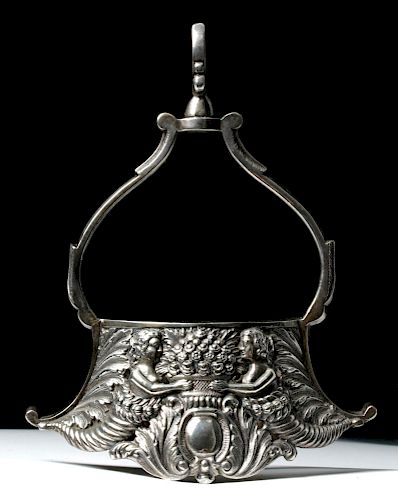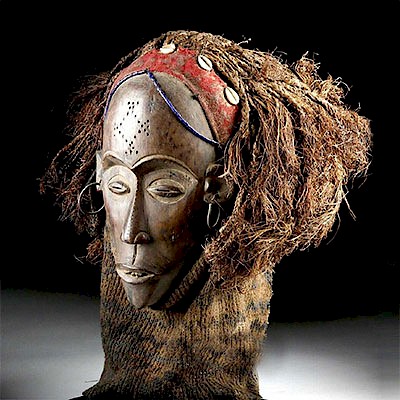18th C. Colonial Silver Stirrup (Estribo), 448 gr.
Lot 121a
About Seller
Artemis Gallery
686 S Taylor Ave, Ste 106
Louisville, CO 80027
United States
Selling antiquities, ancient and ethnographic art online since 1993, Artemis Gallery specializes in Classical Antiquities (Egyptian, Greek, Roman, Near Eastern), Asian, Pre-Columbian, African / Tribal / Oceanographic art. Our extensive inventory includes pottery, stone, metal, wood, glass and textil...Read more
Estimate:
$2,400 - $3,600
Absentee vs Live bid
Two ways to bid:
- Leave a max absentee bid and the platform will bid on your behalf up to your maximum bid during the live auction.
- Bid live during the auction and your bids will be submitted real-time to the auctioneer.
Bid Increments
| Price | Bid Increment |
|---|---|
| $0 | $25 |
| $300 | $50 |
| $1,000 | $100 |
| $2,000 | $250 |
| $5,000 | $500 |
| $10,000 | $1,000 |
| $20,000 | $2,500 |
| $50,000 | $5,000 |
| $100,000 | $10,000 |
| $200,000 | $20,000 |
About Auction
By Artemis Gallery
Apr 4, 2019
Set Reminder
2019-04-04 10:00:00
2019-04-04 10:00:00
America/New_York
Bidsquare
Bidsquare : Ancient / Ethnographic From Around The World
https://www.bidsquare.com/auctions/artemis-gallery/ancient-ethnographic-from-around-the-world-4003
Ancient art from Egypt, Greece, Italy and the Near East, as well as Asian, Pre-Columbian, Native American, African / Tribal / Oceanic, Spanish Colonial, Russian Icons, Fine art, much more! All categories, all price ranges... all legally acquired and guaranteed to be as described or your money back Artemis Gallery info@artemisgallery.com
Ancient art from Egypt, Greece, Italy and the Near East, as well as Asian, Pre-Columbian, Native American, African / Tribal / Oceanic, Spanish Colonial, Russian Icons, Fine art, much more! All categories, all price ranges... all legally acquired and guaranteed to be as described or your money back Artemis Gallery info@artemisgallery.com
- Lot Description
New World, Spanish Colonial period, Uruguay (near Brazilian border), ca. late 18th to early 19th century CE. A dramatic and heavy coin silver (90% silver, 10% copper) stirrup ("estribo" in Spanish). The rectangular hook for attachment has a shell at its base and floral flourishes on either side. This flows down into the straps that meet at a flat, openwork plate for placing the foot. Below that, on either side, is an identical hand-chased motif of two mermaids holding a basket of flowers. The mermaids are wonderfully detailed, with fine facial features. The baskets of flowers rest on a shield-like device with features and vines accenting it and the background. Size: 2.5" L x 6" W x 7.35" H (6.4 cm x 15.2 cm x 18.7 cm) , 448 grams.
Mermaids are a delightfully common theme in Spanish Colonial work. In European lore, they had their roots in Babylonian and Greek chimaera gods, like Triton with his beard and fish tail; the sirens of the Odyssey, "la sirena" in Spanish, introduced the theme of half-woman, half-fish. Mermaids appear in the edges of medieval manuscripts, in heraldry, and on maps. In the New World, they seem to have become fused with indigenous beliefs where they had contact with the Spanish; for example, in Mexico, they seem to have been related to the Aztec deity Chalchiutlicue, the wife of Tlaloc, the god of rain.
Provenance: Whisnant Gallery, New Orleans, Louisiana, acquired over twenty years ago
All items legal to buy/sell under U.S. Statute covering cultural patrimony Code 2600, CHAPTER 14, and are guaranteed to be as described or your money back.
A Certificate of Authenticity will accompany all winning bids.
We ship worldwide and handle all shipping in-house for your convenience.
#122995Excellent condition, with light patina.Condition
- Shipping Info
-
All shipping is handled in-house for your convenience. Your invoice from Artemis Gallery will include shipping calculation instructions. If in doubt, please inquire BEFORE bidding for estimated shipping costs for individual items.
-
- Buyer's Premium



 EUR
EUR CAD
CAD AUD
AUD GBP
GBP MXN
MXN HKD
HKD CNY
CNY MYR
MYR SEK
SEK SGD
SGD CHF
CHF THB
THB


















